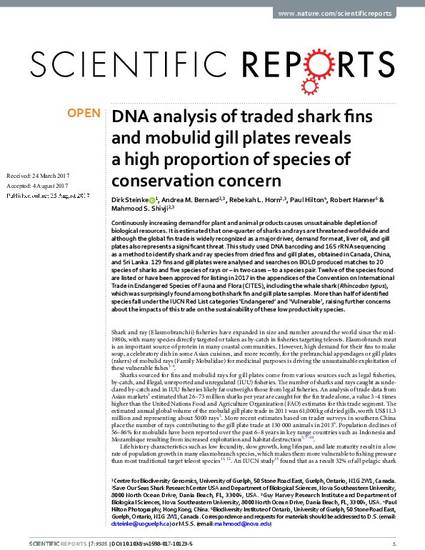
- Conservation biology,
- DNA sequencing,
- Ichthyology
Continuously increasing demand for plant and animal products causes unsustainable depletion of biological resources. It is estimated that one-quarter of sharks and rays are threatened worldwide and although the global fin trade is widely recognized as a major driver, demand for meat, liver oil, and gill plates also represents a significant threat. This study used DNA barcoding and 16 S rRNA sequencing as a method to identify shark and ray species from dried fins and gill plates, obtained in Canada, China, and Sri Lanka. 129 fins and gill plates were analysed and searches on BOLD produced matches to 20 species of sharks and five species of rays or – in two cases – to a species pair. Twelve of the species found are listed or have been approved for listing in 2017 in the appendices of the Convention on International Trade in Endangered Species of Fauna and Flora (CITES), including the whale shark (Rhincodon typus), which was surprisingly found among both shark fin and gill plate samples. More than half of identified species fall under the IUCN Red List categories ‘Endangered’ and ‘Vulnerable’, raising further concerns about the impacts of this trade on the sustainability of these low productivity species.
Available at: http://works.bepress.com/mahmood-shivji/129/

©The Author(s) 2017
Open Access This article is licensed under a Creative Commons Attribution 4.0 International License, which permits use, sharing, adaptation, distribution and reproduction in any medium or format, as long as you give appropriate credit to the original author(s) and the source, provide a link to the Creative Commons license, and indicate if changes were made. The images or other third party material in this article are included in the article’s Creative Commons license, unless indicated otherwise in a credit line to the material. If material is not included in the article’s Creative Commons license and your intended use is not permitted by statutory regulation or exceeds the permitted use, you will need to obtain permission directly from the copyright holder. To view a copy of this license, visit http://creativecommons.org/licenses/by/4.0/.